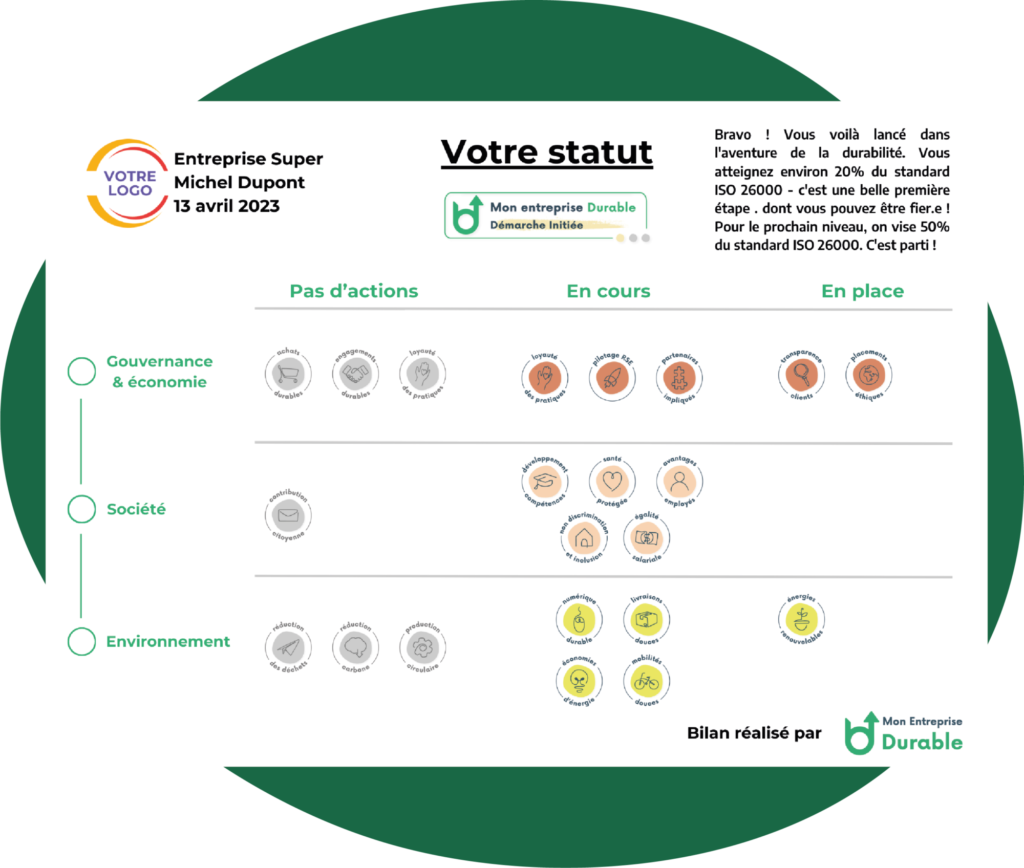What is a corporate carbon footprint?
A carbon footprint, or GHG footprint, is “The CO2 footprint (or carbon footprint) is a quantification of the greenhouse gas emissions generated by a company’s activities.
A company’s balance sheet includes energy and heating consumption, mobility and transport, waste and office automation, all converted into CO2 equivalents” (Climate Services).
But how do you carry out this assessment?
Let’s take a simple example: if I consume 1000 kWh, and I want to know the carbon impact of this consumption, I simply multiply these 1000 kWh by 128g of Co2.
This gives me an impact of 128kg of Co2.
Now that’s simple!
Getting the 128g figure is more complicated 🙂 To arrive at this figure, the FOEN compiled numerous studies.
For your company, there’s no need to worry about this: carbon assessment tools integrate these emission factors, which are regularly updated.
Key points of the article
Why establish a corporate carbon footprint?
Doing a carbon footprint, in itself, doesn’t do much.
But it is essential, because it’s the basis for reducing your GHG emissions.
In 2019, Helvetians emitted almost 14.4 tonnes of CO₂ per person per year, which is huge considering that to effectively slow climate change, each person would need to generate a maximum of 2 tonnes of CO₂ emissions each year.
Switzerland, all the cantons, companies, individuals – everyone is involved in bringing these figures down.
Firstly, at international level, a majority of countries – including Switzerland, of course – have signed the Paris Agreement. This agreement calls on signatory countries to limit global warming to well below 2, preferably 1.5 degrees Celsius, above pre-industrial levels.
To make this long-term temperature objective a reality, countries are aiming to peak greenhouse gas emissions as quickly as possible, in order to achieve a climate-neutral world by mid-century.
At national level, the Swiss Confederation has adopted the CO₂ Act, which aims to achieve a halving of its CO₂ emissions by 2030.
In fact, you can follow the evolution of this and other climate indicators on the MONET 2030 page.
At cantonal level, many cantons have adopted ambitious climate plans.
Geneva, for example, has defined a “strategy for adapting to climate change and reducing greenhouse gas emissions by 60% by 2030 compared with 1990 levels, and achieving carbon neutrality by 2050 at the latest.
“.
As reported by RTS : “From 2024, major Swiss companies will have to submit an annual climate report.
Last week, the Federal Council set out the broad outlines of this project, which is generating both interest and criticism.
[…] In this document, the company will have to highlight the financial risk that climate change represents for its business.
It will also have to detail the impact of its activity on the climate or the environment ” .
How do you assess your company's carbon footprint?
To carry out this assessment, you need to follow the ISO 14064 standard.
This standard defines the requirements for calculating, quantifying, reporting and verifying greenhouse gas emissions.
Several tools are available for making this calculation, free tools such as the Good Planet Foundation’s simulator for companies, simplified tools free of charge, or complete tools for which a fee is charged, such as the Climate Services platform.
Many consultants also offer to carry out carbon assessments for companies.
Once the assessment has been carried out, the most important thing is to identify the actions to be taken to reduce CO2 emissions. This assessment is only the first step in reducing your impact on the environment.
Here are the steps to follow to carry out a corporate carbon footprint:
- Appoint a manager or team to carry out the review.
- Collect the necessary data: it’s important to collect all relevant data concerning the company’s activities.
This data can be collected from the company’s various departments, suppliers and customers. - Analyze the data: once all the data has been collected, it needs to be analyzed to determine the main sources of CO2 emissions.
- Identify opportunities for improvement: once the main sources of emissions have been identified, we need to identify opportunities for improvement in order to reduce CO2 production.
- Putting an action plan in place: Finally, we need to put in place an action plan that will enable us to achieve our emissions reduction targets.
This plan must be realistic and achievable, and must take into account all relevant factors.
(costs, availability of technologies, etc.). - Regularly assess progress and adjust the action plan accordingly.
Now you know the theory behind corporate carbon footprinting, it’s up to you to put it into practice.




